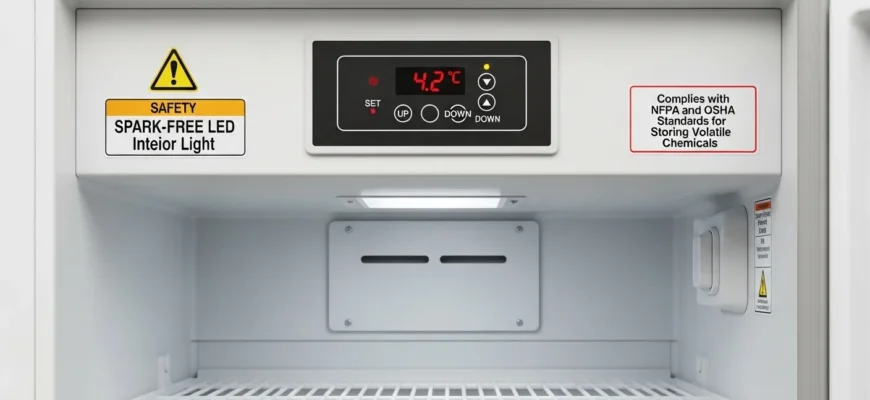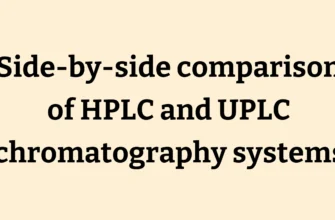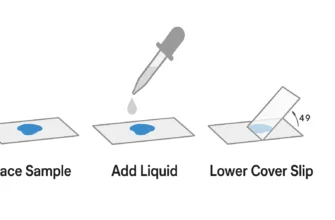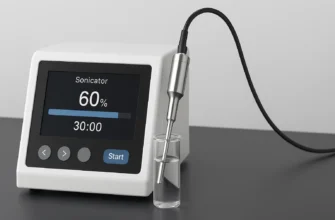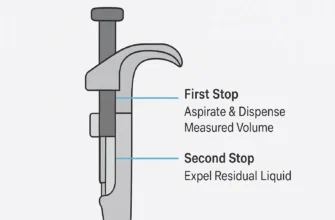Explosion-Proof Refrigerators: Complete Laboratory Safety Guide
Critical Laboratory Safety: Why Standard Refrigerators Are Dangerous
Standard household and commercial refrigerators pose severe explosion risks in chemical laboratories due to their internal electrical components that can generate sparks. These ignition sources include interior lights, thermostats, defrost heaters, light switches, and compressor units. When flammable materials release vapors inside these enclosed spaces, a single spark can trigger a catastrophic explosion.
The devastating consequences became starkly apparent on July 10, 2015, at Michigan State University’s Giltner Hall, where an explosion caused by isopentane stored in an unsealed container within a household refrigerator blew off the refrigerator door and shattered windows over 20 feet away. This incident exemplifies why specialized explosion-proof refrigeration is not optional but mandatory for laboratory safety.
Understanding Hazardous Location Classifications and Refrigerator Requirements
Hazardous Location Classifications
The National Electrical Code (NEC) and OSHA define hazardous locations based on the presence and likelihood of flammable materials. Class I locations involve flammable gases, vapors, or liquids in quantities sufficient to produce explosive mixtures.
Class I, Division 1 (C1D1) areas are the highest risk environments where ignitable concentrations of flammable gases or vapors may exist under normal operating conditions, during maintenance, or due to equipment failure. These locations require the most stringent safety measures.
Class I, Division 2 (C1D2) areas are locations where volatile flammable liquids or gases are handled but normally confined within closed containers or systems. Hazardous atmospheres typically occur only during abnormal conditions like accidental rupture or system breakdown.
ATEX Classifications for European Markets
The European ATEX directive provides parallel classifications for hazardous areas. Zone 1 corresponds to areas where explosive atmospheres are likely to occur occasionally during normal operation. Zone 2 areas are where explosive atmospheres are unlikely during normal operation but may persist briefly if they occur.
Types of Laboratory Refrigeration: Critical Distinctions
Flammable Material Storage (FMS) Refrigerators
FMS refrigerators feature spark-free interiors with all electrical components relocated outside the storage compartment. These units are designed for storing flammable materials in standard, non-hazardous laboratory environments. Key features include:
-
No internal electrical components that could trigger ignition
-
Hermetically sealed compressors located externally
-
Magnetic door gaskets for positive sealing
-
Manual defrost systems to eliminate defrost heaters
-
UL listing as special purpose refrigerators for flammable material storage
Leading manufacturers offer comprehensive FMS lines, including Thermo Scientific ES Series FMS refrigerators and freezers, Revco FMS High-Performance models, and TSX Series manual defrost freezers.
True Explosion-Proof Refrigerators
Explosion-proof refrigerators represent the highest level of protection, engineered to prevent ignition of flammable vapors both inside and outside the unit. These units are specifically designed for Class I, Division 1 hazardous locations and must meet stringent requirements:
-
All electrical components enclosed in vapor-proof, explosion-proof enclosures
-
Hermetically sealed compressors with explosion-proof electrical connections
-
Compliance with UL standards for hazardous locations Class I, Groups C & D
-
Hardwired installation by qualified electricians – no plug connections permitted
-
ATEX certification for European markets (Group II, Category 2 or 3)
Regulatory Compliance and Safety Standards
NFPA 45:2024 Requirements
The NFPA 45:2024 Standard on Fire Protection for Laboratories Using Chemicals establishes comprehensive requirements for laboratory fire protection. The 2024 edition strengthens requirements for hazardous chemical storage, fire suppression systems, and ventilation. Chapter 9 specifically addresses flammable and combustible liquids, including refrigerated storage requirements.
OSHA and UL Standards
OSHA 1910.307 specifies requirements for electrical equipment in hazardous locations. All refrigeration equipment for flammable storage must be UL listed under appropriate standards:
-
UL 471 for Commercial Refrigerators and Freezers
-
UL 1275 for Flammable Liquid Storage Cabinets
-
Specific UL recognition for hazardous location use
Essential Safety Features and Engineering
Electrical Component Isolation
Explosion-proof refrigerators employ multiple strategies to eliminate ignition sources:
-
Intrinsically safe circuits with energy levels below ignition thresholds
-
Hermetically sealed compressors preventing vapor infiltration
-
Vapor-proof enclosures for all electrical connections
-
Nonsparking magnetic door gaskets eliminating static discharge risks
Temperature Control and Monitoring
Advanced temperature control systems ensure both safety and performance:
-
Temperature sensors in explosion-proof housings
-
Digital displays with high/low temperature alarms
-
Temperature mapping capabilities for validation
-
Remote alarm contacts for continuous monitoring
Construction and Security Features
Robust construction addresses both safety and security needs:
-
Corrosion-resistant interiors suitable for chemical environments
-
Self-closing doors with magnetic gasket seals
-
Security locks preventing unauthorized access
-
Manual defrost systems eliminating automatic defrost ignition sources
Selection Criteria and Installation Requirements
Risk Assessment Protocol
Proper selection begins with comprehensive risk assessment:
-
Chemical inventory analysis – Identify all flammable materials requiring refrigerated storage
-
Hazardous area classification – Determine if location qualifies as Class I, Division 1 or 2
-
Regulatory compliance verification – Ensure equipment meets applicable NFPA, OSHA, and UL standards
-
Capacity and configuration planning – Select appropriate size and features for operational needs
Installation and Maintenance Requirements
Professional installation is mandatory for explosion-proof units:
-
Hardwired electrical connections by qualified electricians only
-
Proper grounding to prevent static electricity buildup
-
Sealed conduit systems preventing gas migration
-
Regular inspection and maintenance to ensure ongoing compliance
Leading Manufacturers and Model Options
Thermo Scientific Product Lines
Thermo Scientific offers comprehensive explosion-proof and FMS refrigeration solutions:
-
ES Series FMS refrigerators and combination units
-
Revco FMS High-Performance models meeting US Pharmacopeia standards
-
TSX Series manual defrost freezers for flammable material storage
-
ATEX-certified models for European markets
Specialized Features
Modern explosion-proof refrigerators incorporate advanced safety technologies:
-
Hydrocarbon refrigerants (R-290, R-600a) for environmental compliance
-
CFC and HCFC-free insulation meeting environmental regulations
-
Access ports for external monitoring connections
-
Reversible doors for flexible installation
Economic and Risk Management Considerations
Cost-Benefit Analysis
The financial investment in proper explosion-proof refrigeration is minimal compared to potential catastrophic losses. Historical incidents demonstrate costs extending far beyond immediate damage:
-
Equipment replacement and facility reconstruction
-
Research data and sample losses potentially worth years of work
-
Operational downtime during cleanup and renovation
-
Insurance premium increases and potential legal liability
-
Regulatory fines and compliance enforcement actions
The Harvard University fact sheet reports one laboratory explosion resulting in approximately $200,000 in damage plus extended operational downtime. The Michigan State University incident required emergency response, building evacuation, and extensive cleanup.
Preventive Investment Strategy
Proactive investment in certified explosion-proof equipment represents sound risk management:
-
Regulatory compliance avoiding costly violations and fines
-
Insurance benefits potentially reducing premium costs
-
Operational continuity preventing research interruptions
-
Personnel safety protecting irreplaceable human resources
-
Institutional reputation maintaining research credibility
Non-Negotiable Laboratory Safety Requirements
Explosion-proof refrigeration is not optional equipment but essential safety infrastructure for any laboratory handling flammable materials. The distinction between flammable material storage (FMS) units for general laboratory use and true explosion-proof refrigerators for hazardous locations is critical for proper selection and regulatory compliance.
Modern explosion-proof refrigerators incorporate sophisticated engineering solutions including hermetically sealed compressors, intrinsically safe electrical systems, and vapor-proof enclosures to eliminate all potential ignition sources. Compliance with NFPA 45:2024, OSHA 1910.307, and UL standards ensures both regulatory adherence and operational safety.
The investment in proper explosion-proof refrigeration equipment, coupled with professional installation and regular maintenance, represents a fundamental commitment to laboratory safety that protects personnel, preserves research assets, and ensures institutional continuity. Given the catastrophic consequences of improper storage demonstrated by incidents like the Michigan State University explosion, the choice of appropriate refrigeration technology is among the most critical safety decisions laboratory managers will make.

